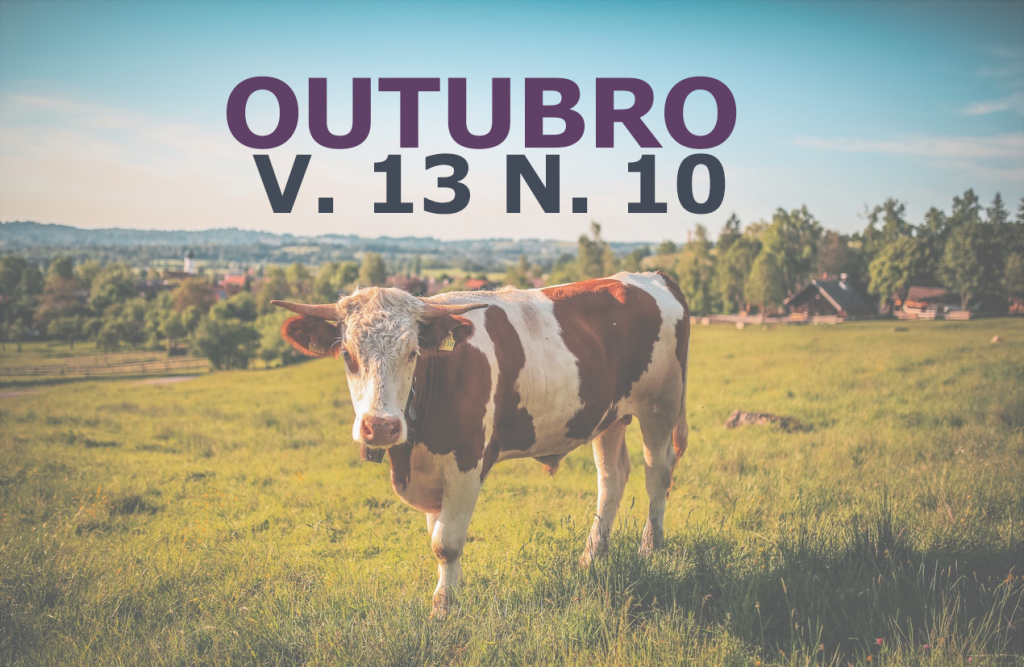Potencial de fecundação diária de Touros Nelore na monta a campo selecionados por avaliações andrológicas e comportamento sexual
DOI:
https://doi.org/10.31533/pubvet.v13n10a421.1-11Palavras-chave:
Andrologia, CAP, desempenho reprodutivo, libido, Nelore, Zebu.Resumo
Foi avaliado o desempenho de touros Nelore em cobertura a campo por 4 dias com alta pressão de cios sincronizados, quanto a sua classificação andrológica por pontos(CAP) e teste de libido e testados em 4 tratamentos: T1 = CAP > 75 pontos e alta libido; T2 = CAP < 75 pontos e alta libido; T3 = CAP > 75 e baixa libido; T4 = CAP < 75 pontos e baixa libido. Os cios foram observados de 18 a 78 horas após a sincronização com os maiores percentuais registrados às 42 (40,1%) e às 54 (30,4%) horas. Foram registrados, em média, 24,62 ± 2,11 fêmeas em cio por lote com pico de 9,87 ± 1,55 fêmeas/touro/dia. O número médio de fêmeas gestante por touro foi de 9,25 ± 3,2. A taxa média de gestação foi de 33,33%, variando de 22,44 no T4 a 47,82% no T1 (p<0,05). Observaram-se mais altas taxas com 42 horas (42,67%) após a retirada os implantes, com destaque para o T2 com 52,38 % de prenhes, porém com as menores taxas nos períodos subsequentes, quando comparado aos demais tratamentos. Embora fosse constatada diminuição geral nas taxas de prenhes às 54 horas, após a retirada dos implantes, os touros do T1 mantiveram as maiores taxas em relação aos demais tratamentos. Conclui-se que agregando CAP e teste de libido, pode-se compreender potencial de monta para touros Nelore frente a alto índice de manifestação de cios, permitindo assim maior pressão de seleção e melhor investimento na aquisição de touros de alto valor genético.
Downloads
Publicado
Edição
Seção
Licença
Copyright (c) 2019 Daniel Fábio Salvador, Luiz Altamiro Garcia Nogueira, Venício José de Andrade

Este trabalho está licenciado sob uma licença Creative Commons Attribution 4.0 International License.
Você tem o direito de:
Compartilhar — copiar e redistribuir o material em qualquer suporte ou formato
Adaptar — remixar, transformar, e criar a partir do material para qualquer fim, mesmo que comercial.
O licenciante não pode revogar estes direitos desde que você respeite os termos da licença. De acordo com os termos seguintes:
Atribuição
— Você deve dar o crédito apropriado, prover um link para a licença e indicar se mudanças foram feitas. Você deve fazê-lo em qualquer circunstância razoável, mas de nenhuma maneira que sugira que o licenciante apoia você ou o seu uso. Sem restrições adicionais
— Você não pode aplicar termos jurídicos ou medidas de caráter tecnológico que restrinjam legalmente outros de fazerem algo que a licença permita.





